Art tools transform MS experiences by adapting to your unique needs, making creativity accessible despite physical limitations. Specialized brushes, ergonomic easels, and digital platforms help you overcome dexterity challenges while reducing stress and inflammation. You’ll gain emotional release, improved motor control, and meaningful connections through artistic expression. Color therapy specifically addresses visual symptoms and fatigue. Discover how these adaptive tools can release your creative potential while managing MS symptoms more effectively.
The Emotional Power of Adaptive Art Tools
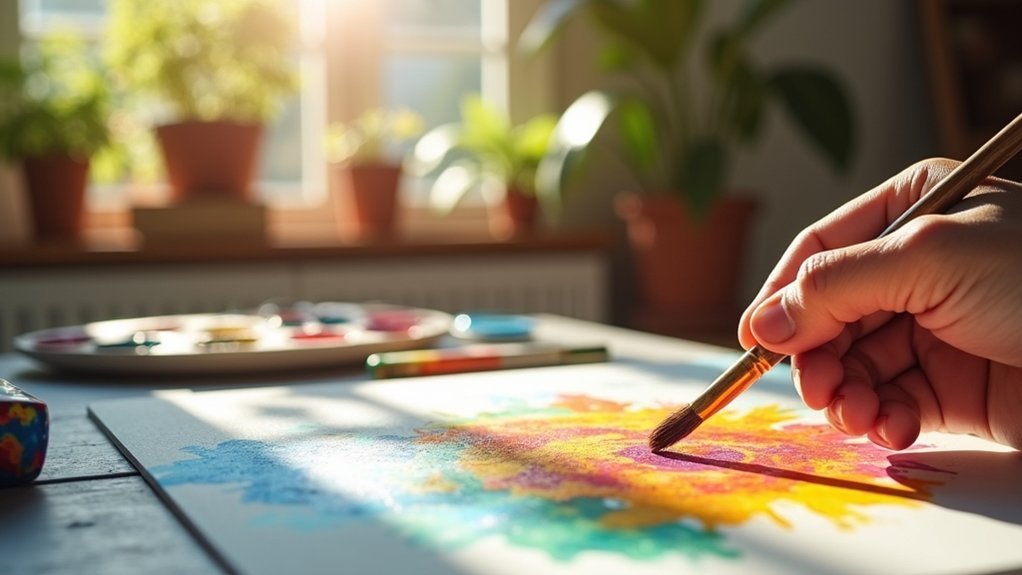
When individuals with multiple sclerosis engage with adaptive art tools, they often experience profound emotional transformations that extend far beyond the canvas.
You’ll find these specially designed tools create pathways to improved self-esteem and hope, as measured by clinical scales like the Rosenberg Self-Esteem Scale and Herth Hope Index.
These adaptive implements don’t just facilitate art creation—they empower you to externalize emotions, regulate mood fluctuations, and develop greater self-efficacy in managing MS symptoms.
When verbal expression becomes challenging, modified brushes, ergonomic supplies, and assistive devices offer alternative channels for communicating complex feelings.
By overcoming physical limitations through creative adaptation, you’re actually reclaiming agency and reinforcing your identity beyond your diagnosis.
The resulting sense of control becomes a powerful antidote to the uncertainty that often accompanies MS.
Studies show that participation in creative art programs involving art therapy techniques can provide a multi-layered sensory experience that helps free up blocked emotions resulting from trauma.
Finding Freedom Through Modified Brushes and Easels
The liberation that comes with specialized art tools transforms physical limitations into creative possibilities for people with MS. You’ll find that brushes with ergonomic handles reduce hand fatigue, while weighted tools stabilize tremors, giving you precision you might’ve thought was lost.
Adjustable easels accommodate your balance issues and limited arm strength, letting you position your work at the perfect angle. These modifications aren’t just practical—they’re empowering.
Art becomes freedom when your tools honor your body’s truth instead of fighting against it.
When you can create art independently, your confidence grows alongside your motor skills. The repetitive, controlled movements strengthen muscles and promote neuroplasticity, while the frustration-free experience enhances your emotional well-being. Therapeutic arts approaches can address multiple dimensions of wellness simultaneously, supporting physiological, psychological, and social needs of MS patients.
With these adaptive tools, you’ll enjoy longer, more productive art sessions without excessive strain, keeping you connected to the creative community that nurtures your spirit.
Color Therapy: How Specialized Palettes Impact MS Symptoms
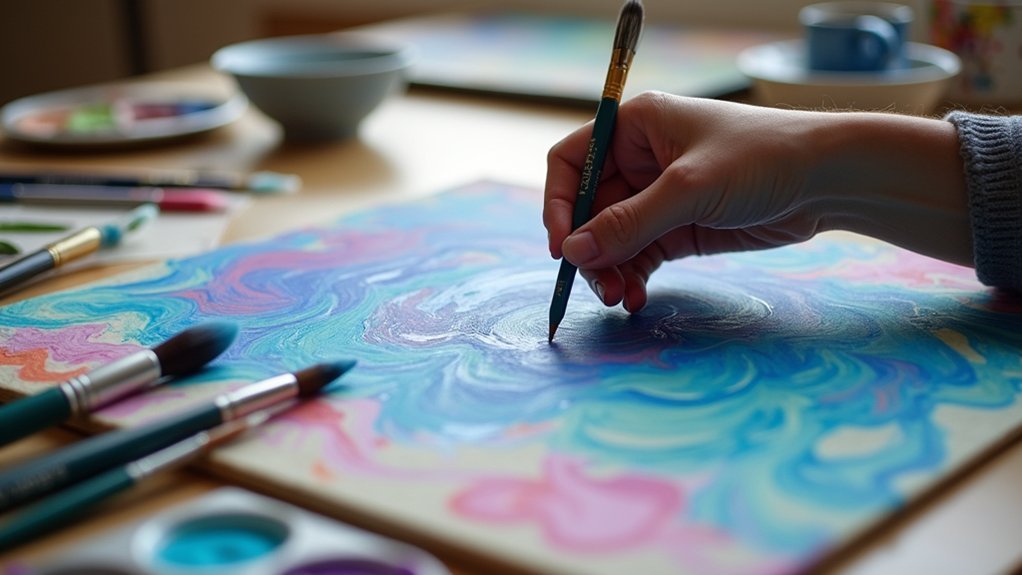
You’ll find visual relief from MS symptoms through color therapy techniques that use blue and green tones to reduce stress and promote relaxation.
Mood-enhancing color schemes, like energizing reds and oranges, can help combat fatigue and boost cognitive function when you’re experiencing MS-related challenges.
Personalizing your art palette to include colors that resonate with your emotional needs creates a therapeutic environment that supports both your artistic expression and symptom management. When incorporated as complementary medicine, color therapy can be used alongside conventional treatments to provide holistic support for MS symptom management without replacing standard medical care.
Visual Relief Techniques
Visual perception challenges in multiple sclerosis patients can be considerably alleviated through specialized color therapy techniques.
You’ll find that MS often impairs color vision along red-green and blue-yellow axes, affecting both parvocellular and koniocellular pathways.
Tailored color palettes can reduce visual fatigue by optimizing visual processing pathways that remain intact. Using tools like the Cambridge Color Test, you can identify your specific chromatic discrimination needs and develop personalized approaches to manage symptoms.
These adaptive color displays may work synergistically with other complementary therapies you’re already using.
As your color vision impairments might progress faster than the general population, incorporating technological solutions with variable light therapies could provide ongoing relief. Research has demonstrated that MS patients experience progressive impairment in color discrimination with age at rates faster than control groups.
Specialized displays that automatically adjust to your visual needs represent promising innovations in managing the visual symptoms of MS.
Mood-Enhancing Color Schemes
While conventional treatments focus on physical symptoms of multiple sclerosis, mood-enhancing color schemes offer a complementary approach that targets emotional wellbeing.
You’ll find that specific colors can greatly impact your psychological state—warm tones like red and orange may combat fatigue, while cool blues and greens reduce anxiety and stress. Despite color vision impairments common in MS, customized palettes can still provide therapeutic benefits.
Color therapy works on multiple levels, allowing you to express emotions non-verbally while potentially stabilizing mood swings. When combined with other complementary approaches like photobiomodulation or omega-3 supplementation, these visual interventions may enhance overall treatment outcomes. Recent research suggests that integrating red light therapy techniques with color therapy could help reduce inflammation associated with MS progression.
Though research remains limited, many MS patients report improved mental wellbeing through intentional color exposure, suggesting this accessible therapy deserves greater attention in thorough MS management.
Building Physical Strength Through Creative Expression
For individuals managing multiple sclerosis, engaging in artistic expression offers surprising physical benefits beyond creative fulfillment. When you work with art materials like beads, watercolors, or clay, you’re actually exercising muscles and improving motor coordination in ways that feel enjoyable rather than therapeutic.
The rhythmic motions involved in artistic creation help enhance gait, balance, and upper limb function while reducing your perceived fatigue. Sessions should be continually adjusted to accommodate the individual limitations of MS.
- Movement without pressure – Art encourages you to move body parts that aren’t affected by pain, shifting attention to positive sensory experiences.
- Flow state benefits – Becoming absorbed in creative work reduces stress and muscle tension while sustaining physical engagement.
- Empowerment through creation – Completing artistic projects builds confidence for continued physical activity and gentle strength development.
Digital Art Platforms Designed for Limited Mobility
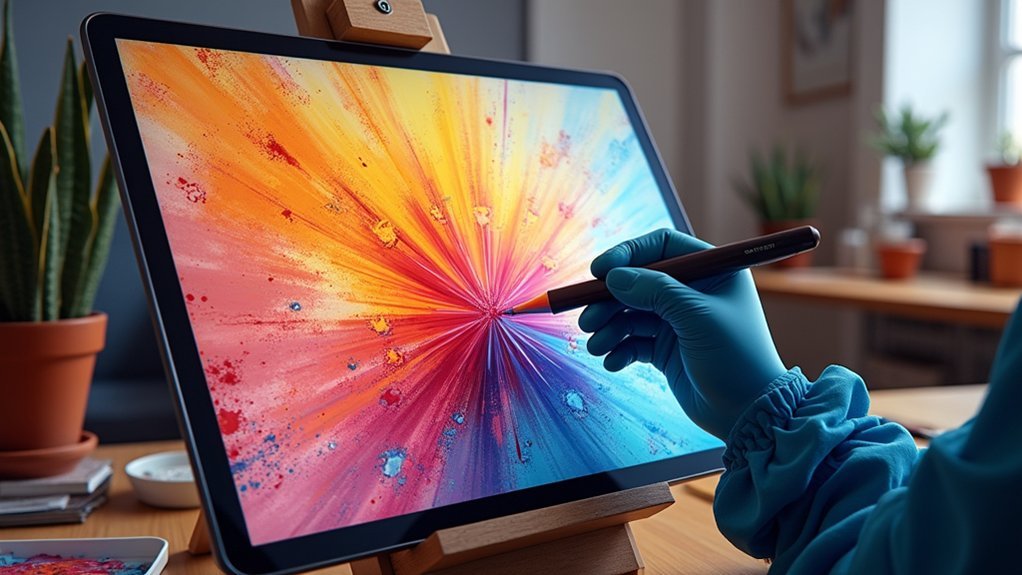
Digital art platforms have revolutionized creative possibilities for people with MS who face mobility challenges.
You’ll find touchscreen interfaces that support finger or stylus input, reducing the need for precise motor control when traditional art tools become difficult to manage.
Voice commands and eye-tracking technology enable hands-free creation if your dexterity is severely limited.
These platforms integrate with adaptive devices like mouth sticks and specialized controllers, while AI-powered tools can smooth tremor-affected strokes.
You can customize shortcuts and interface layouts to match your specific needs, while undo functions eliminate frustration from unintended movements.
Unlike traditional media, digital art reduces physical strain, allowing longer creative sessions without fatigue.
Plus, online exhibitions like the MS Plus Virtual Art Show connect you to communities despite mobility barriers.
These tools perfectly align with MSAA’s mission of improving lives today for the MS community through accessible and supportive resources.
Community Connections: Shared Art Making With MS
Building connections through art can transform your MS journey from an isolating experience into a shared creative adventure.
Group art activities foster emotional support while collaborative workshops strengthen community bonds among participants facing similar challenges. Multiple modalities under art therapy provide diverse engagement options for everyone regardless of ability level. The MSAA Art Showcase celebrates creativity while raising awareness through public displays of work created by individuals with MS.
When you engage in community art making, you’ll experience:
- Enhanced social support – Studies show significant improvements in social connection and self-efficacy through structured art therapy programs.
- Emotional expression in a safe space – Non-verbal expression offers therapeutic release without judgment.
- Renewed sense of purpose – Contributing to community art projects rebuilds confidence and creates meaningful connections with others who understand your experience.
Mindfulness and Art: Tools That Center the MS Experience
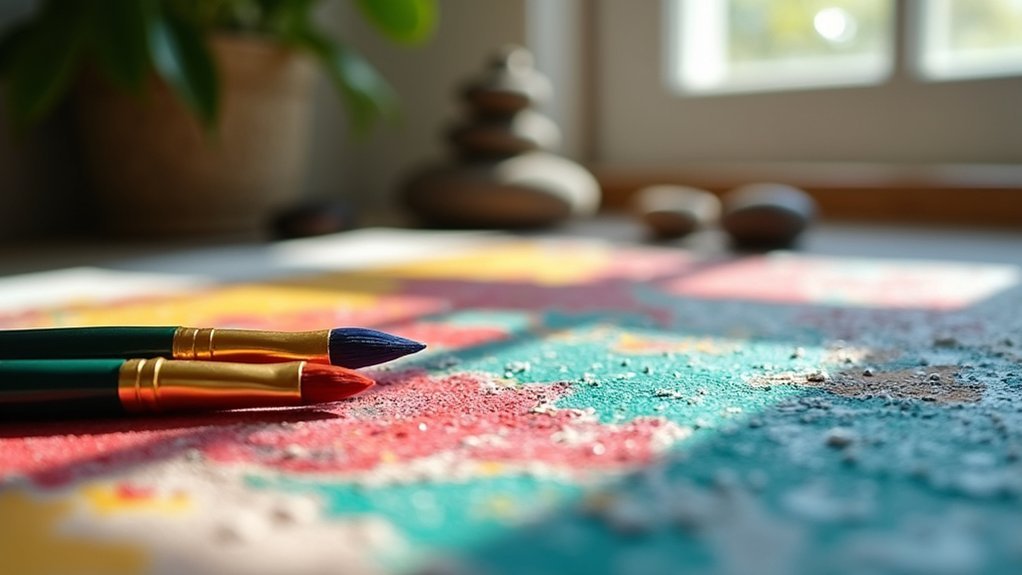
Mindfulness and art therapy merge to create powerful tools for traversing the complex MS journey, offering both emotional relief and cognitive benefits.
When you engage with art mindfully, you’re accessing a unique self-management strategy that research shows can reduce symptoms and enhance emotional well-being.
You don’t need to leave home to experience these benefits—teleconference MBAT programs make therapy accessible even with mobility challenges.
The combination works synergistically: mindfulness enhances your sensory experience and creative flow, while art provides a tangible outlet for expressing difficult emotions about your MS experience.
Recent research conducted at an academic center registry demonstrated the feasibility and acceptability of mindfulness-based art therapy delivered through videoconferencing for adults with multiple sclerosis.
Over time, these practices may help mitigate cognitive challenges associated with MS while giving you space to process your feelings in ways words alone can’t capture.
From Frustration to Creation: Overcoming Dexterity Challenges
When manual dexterity begins to falter in MS patients, creative aspirations often seem to slip away like paint through trembling fingers.
Yet the evidence shows that up to 76% of people with MS face this challenge—and many find their way back to artistic expression through adaptive tools and techniques.
You don’t have to abandon your creative journey when your hands don’t cooperate.
Recent research shows that manual dexterity assessments can predict cognitive function in multiple sclerosis patients, highlighting the importance of maintaining hand function.
Consider these approaches:
- Embrace assistive technology – Grip aids and adaptive tools can transform your ability to hold brushes and manipulate materials.
- Explore digital alternatives – Tablets and art software require less physical dexterity while offering rich creative possibilities.
- Practice collaborative art – Working with others distributes physical demands while enhancing social connection.
The Science Behind Art’s Therapeutic Effects on MS Symptoms
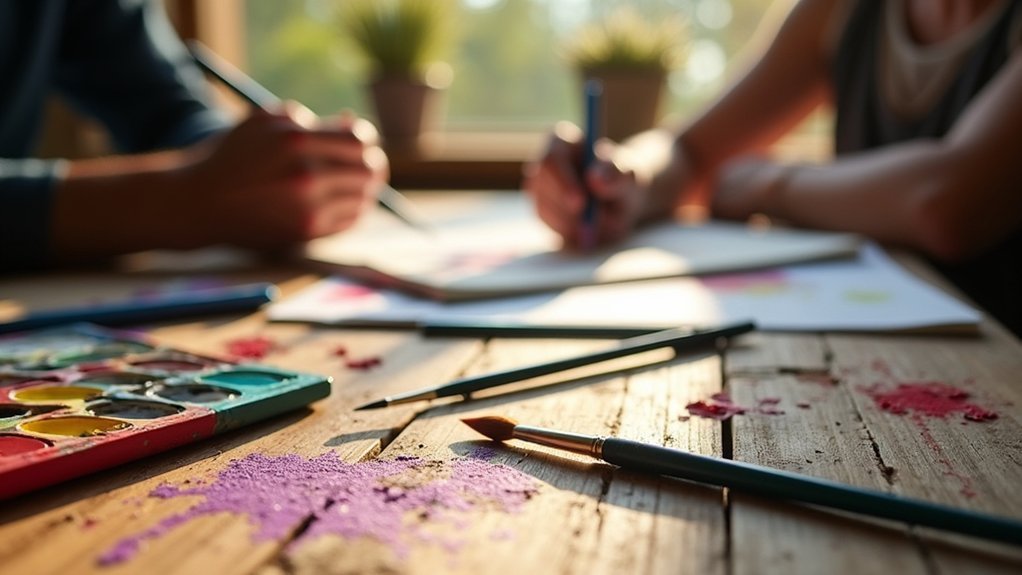
Research shows how art therapy directly impacts your neurological pain through the release of endorphins and redirection of neural pathways.
The creative process stimulates neuroplasticity, helping your brain forge new connections that may bypass damaged areas affected by MS.
Initial studies from the Cleveland Clinic’s Arts & Medicine Institute indicate statistically significant improvements in overall well-being and happiness among participants with chronic conditions including MS.
Your engagement with art reduces stress hormones like cortisol, potentially decreasing inflammation—a key factor in MS symptom flare-ups.
Neurological Pain Relief
The complex neurological pain experienced by multiple sclerosis patients often responds positively to art-based interventions through several scientific mechanisms.
When you engage in creative activities, your brain activates multiple sensory pathways that can effectively distract from pain signals while simultaneously improving your mood and emotional state.
Research confirms that combining art with cognitive-behavioral techniques provides significant benefits for pain management:
- Sensory engagement – Art-making occupies different neural pathways, reducing pain perception
- Emotional processing – Expressing feelings through visual arts helps regulate emotions connected to pain experiences
- Stress reduction – Creating art decreases anxiety and stress levels that typically amplify pain sensations
You’ll find that regular artistic practice offers a drug-free approach to managing chronic pain, giving you both immediate relief and cumulative benefits.
Creativity Boosts Neuroplasticity
Every creative act you engage in fundamentally reshapes your brain through neuroplasticity, offering particular benefits for multiple sclerosis patients. When you paint, draw, or sculpt, you’re stimulating cognitive pathways that promote neural reorganization and cortical remapping—essential processes for adapting to MS-related changes.
Your brain’s remarkable ability to compensate for damage relies on preservation of structural architecture. Art provides the mental training that accelerates this adaptation. Creative activities enhance neural reserve, with different benefits observed between childhood and adult-onset MS patients. Studies consistently show that enriched environments contribute significantly to promoting neuroplasticity in MS patients, making art studios ideal therapeutic settings.
The molecular mechanisms behind these improvements include reduced inflammation, decreased oxidative stress, and potential enhancement of remyelination processes.
What’s most promising is how these creative interventions can be personalized to your specific symptoms, leveraging your brain’s natural adaptability while providing meaningful symptom relief through non-pharmaceutical means.
Stress-Inflammation Connection
At the heart of art’s powerful effects on MS management lies a fascinating biological chain reaction between stress and inflammation. When you engage in creative activities, you’re actually interrupting the harmful cycle where psychological stress triggers inflammatory responses that worsen MS symptoms.
Your body’s stress response system—including the HPA axis—calms down during artistic expression, reducing inflammatory cytokines that damage myelin.
- Creating art activates your parasympathetic nervous system, shifting your body from “fight-or-flight” to “rest-and-digest” mode.
- Mindfulness combined with creativity helps regulate cortisol levels and reduce pro-inflammatory markers like IL-6.
- The emotional release and self-efficacy you gain through art therapy act as biological buffers against neuroinflammation.
This science explains why many patients report fewer flare-ups when regularly practicing artistic activities. A comprehensive study demonstrated that art therapy led to a 23% decrease in anxiety levels among MS patients after just three months of treatment.
Frequently Asked Questions
How Do Insurance Companies Typically Cover Art Therapy for MS Patients?
You’ll find insurance coverage for art therapy varies widely. Most insurers require providers to hold state mental health licenses beyond art therapy certification, and coverage depends on your location and specific insurance plan.
Can Art Therapy Potentially Slow MS Disease Progression?
There’s no direct evidence that art therapy slows MS progression. However, it may indirectly help by reducing your stress and improving your wellbeing, which could potentially impact your overall health and disease management.
Are There Certifications for Art Therapists Specializing in Neurological Conditions?
While there’s no specific certification for neurological conditions, you’ll want to look for an ATR-BC credentialed therapist through the Art Therapy Credentials Board who has additional training or experience with neurological disorders.
What Affordable Art Tools Work Best for Severe Tremors?
For severe tremors, you’ll find the best affordable tools are foam grips for brushes, sponge painting tools, ergonomic handles, and makeup wedges. These provide stability while allowing you to express yourself artistically.
How Can Caregivers Incorporate Art Therapy at Home?
You can introduce simple art activities like coloring or clay work, adapt tools for easier grip, participate alongside your loved one, and create a relaxed, judgment-free environment that celebrates expression rather than perfection.
In Summary
You’ve seen how adaptive art tools can transform your MS journey. They’re not just equipment—they’re gateways to emotional healing, physical strengthening, and community connection. Whether you’re using modified brushes, digital platforms, or specialized easels, you’re reclaiming creative power that MS threatens to take away. Your artistic expression matters, and with these tools, you’ll continue finding new ways to communicate your unique experience.

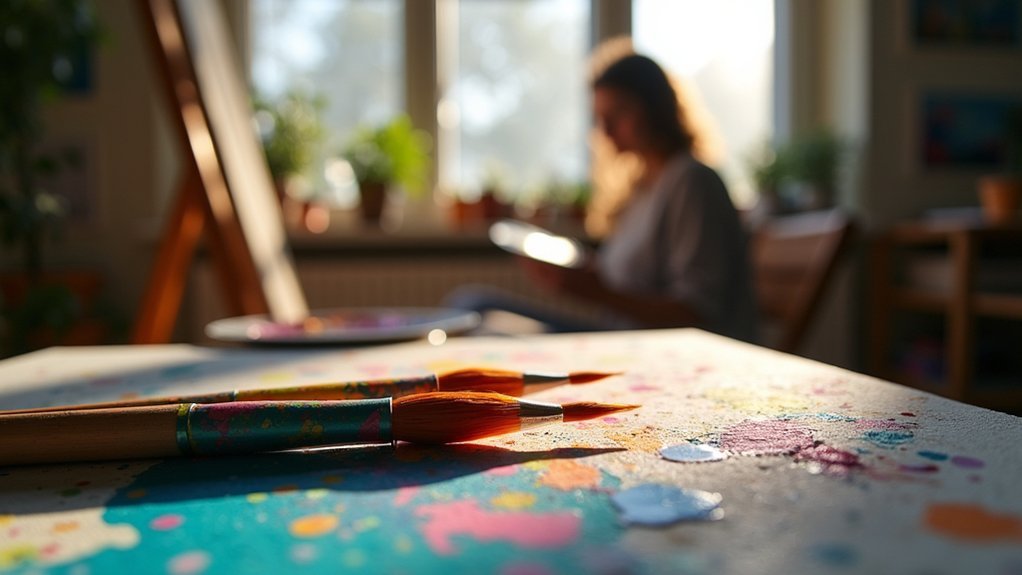



Leave a Reply